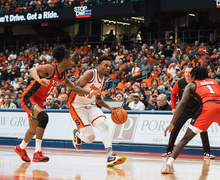Crooked Arrows brings lacrosse, Native American heritage to silver screen
Lacrosse isn’t just a sport for Ira Huff. He is a member of the Tonawanda Seneca Nation, so the game is part of his way of life.
‘We don’t lie when we say it’s in our blood,’ said Huff, a junior English and textual studies major. ‘It’s been passed down from generation to generation.’
Huff played for his reservation team, the Tonawanda Braves, and says he never passes up the opportunity to play. In his nation, lacrosse is a medicine game that is played to heal the sick. The traditional sport will be thrust into the spotlight in ‘Crooked Arrows,’ a film premiering at 8 p.m. Wednesday at the OnCenter in Syracuse. The film is the first mainstream lacrosse movie to premiere on the silver screen and will officially be released June 1.
The movie is a fictional account of a Native American lacrosse team in a tournament and took twelve years to get into production. The story focuses on a mixed-blood Native American lacrosse coach, played by actor Brandon Routh, who takes over a team while reigniting his own heritage, according to the movie’s website.
Neal Powless, the assistant director of the Native Student Program at Syracuse University, began his involvement as co-producer of ‘Crooked Arrows’ when the film’s producers came to the Onondaga Nation to recruit Native American lacrosse players and didn’t get the turnout they hoped for. He said producers believed America wasn’t ready for a lacrosse movie.
Powless is no stranger to the sport. He played professionally for seven years and competed in the World Lacrosse Championships as part of the Iroquois team. Some of the players who auditioned for roles in ‘Crooked Arrows’ were handpicked by Powless from teams he has coached.
‘Some weren’t used because they were great athletes but couldn’t act or great actors that didn’t look the part. They were looking for players who had it all,’ he said.
As a member of the Onondaga Nation, Powless was asked to read the script and make revisions. He said the original draft borrowed from different native communities but was streamlined to reflect his nation, the birthplace of lacrosse.
Alex Jimerson, a 2011 SU alumnus and member of the Seneca Nation, believes that Powless was the perfect fit for the job.
‘His lacrosse resume speaks for itself,’ he said. ‘I like the fact that they recruited local native lacrosse players. I have friends in the movie who I’m really excited for.’
The Onondaga Nation financially backed ‘Crooked Arrows,’ and although the team inthe movie is fictional and not from the Haudenosaunee Nations, Powless adapted the script for the area by incorporating traditions and aspects of heritage.
Powless is also producing a documentary about the history of lacrosse for the DVD release of ‘Crooked Arrows.’ He hopes to screen the documentary on the History Channel and Discovery Channel for a wider release.
He felt proud of the product he has seen during pre-screenings. He said that the end drew emotional responses from both Native American and non-Native American audiences. The film shows what contemporary Native Americans look like, he said.
Powless said the film helps to answer questions that Native American SU students have a hard time fielding. The goal of the film was to escape the stereotypes of modern Native Americans by showing them in a realistic, if not fictional, light.
‘They have to speak for their entire heritage, and they struggle with that every day. This movie is all about education and showing audiences what it’s really like,’ Powless said.
Routh, the lead actor of the film, is of Native American descent but is not associated with a nation. Most members of the ‘Crooked Arrows’ team are Native American, including five from the Onondaga Nation.
Powless is glad that the film will first be screened in the nation where lacrosse’s origins take root.
‘The movie uses Native culture and heritage to show values to the audience, and it’s about a sacred sport from the nation,’ Powless said. ‘It only makes total sense that people will get to see the movie first here.’
Native Huff also believes that the Onondaga Nation’s input into the movie allowed the Native American actors to portray themselves through their own lenses. Although personally not involved in the movie, he felt glad that a movie with a modern Native American perspective was made.
‘We have input in this film, and it’s a movie about one of our most cherished traditions,’ he said. ‘What’s not to like?’
Published on May 9, 2012 at 12:00 pm
Contact Erik: ervanrhe@syr.edu | @therealvandyman





